Emerald Info
Back to Beryl / Emerald
General
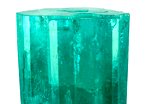 |
| Emerald from Muzo * |
Emerald belongs to the multi-colored beryl family, and is a beryllium-aluminium-silicate with the Mohs hardness of 7.5 - 8. Its green color comes from traces of chrome, vanadium or iron within the usually colorless beryl mineral. Emeralds grew during complicated tectonic processes whose traces are still visible within the crystals: foreign, tiny crystals, fissures, fluids, bubbles etc. These inclusions are called "jardin" (French word for "garden"). A decent "jardin" doesn't reduce the value of an emerald as long as it is not spoiling the color or transparency.
* Photo by kind permission of © www.irocks.com.
History
 |
| Zubara Mines * |
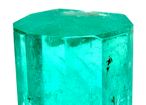 |
| Emerald from Chivor * |
Since hundreds of years emeralds were mined in Peru by the Incas. They regarded emeralds as holy stones. In 1532 Francisco Pizarro (1476-1541) and his Spanish conquistadors conquered the Inca imperium in the Peru mountains. Because the Spaniards were unsuccessful in finding naturally occurring emeralds, their soldiers confiscated all available emeralds, sometimes as large as pigeon eggs. To test their genuineness, they pounded the stones with hammers because they believed that genuine emeralds could not be broken. Sooner or later they learned that this "green glass" was more valuable... Finally Spanish galleons carried enormeous quantities of all available emeralds to Spain. Many ships sank, and therefore a lot of finest and most valuable emeralds are still "sleeping" at the bottom of the Carribean Sea.
* Photo by kind permission of © www.irocks.com.
* Photo by kind permission of © Harjo Neutkens.
Formation and Resources
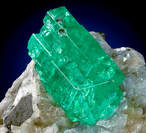 |
| Emerald from Coscuez * |
Other emeralds grew in pegmatite deposits similar to the hydrothermal process. But here the hot water was replaced by magma or molten rock. When the magma began to cool, the necessary elements were left in solution and could also create emeralds.
Emeralds are found worldwide. The most sought-after gems come from the "Emerald belt" in the Cordillera Oriental, a part of the Colombian Andes, with its famous mining areas Muzo, Chivor, Cosquez and La Pita. The Muzo area is located near the town Muzo, about 100 km northwest of Bogota. Muzo and Coscuez (about 12 km north of Muzo) are the major mine areas in the Muzo area. The Chivor mining area is located about 90 km east-northeast of Bogota. The two major mines are Chivor and Gachala near the town Somondoco. Chivor is a very old mine which was already ran by the Chibcha Indians in pre-Spanish times. The mine was re-discovered in 1896.
Until today many illegal miners ("Guaqueros") are busy in the Colombian emerald mining areas.
* Photo by kind permission of © www.themineralgallery.com.
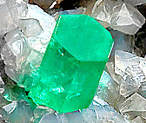 |
| Emerald from La Pita * |
Valuable emeralds come also from Africa and Brazil. Some of them even look like Colombian ones, and in general they are cleaner than them. Today Zambia and Zimbabwe are important sources for good stones. In the northern part of Zambia mines were established near Kagem, Kitwe, Miku und Mufulira.
Since 1984 light green to yellowish-green emeralds were found near Dayakou / Wenshan Mountains / Yunnan / China. They occur in up to 1.5 m thick pegmatite veins, accompanied by feldspar, mica, quartz, scheelite, and tourmaline.
* Photo by kind permission of © www.themineralgallery.com.
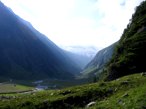 |
| Habach Valley * |
 |
| Habachtal Mine * |
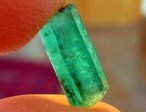 |
| Habachtal Emerald * |
* * Photos by kind permission of © Harjo Neutkens.
* Photo by kind permission of © www.granat.at.
Color and Quality
Emeralds from the Muzo area show a warm, slightly yellowish grass-green. Stones from Chivor show a more blueish green. Both types, in excellent condition, are very desirable and expensive.
Brazilian emeralds are usually lighter than Colombian ones. Zambian emeralds have a distinct bluish undertone, emeralds from Zimbabwe show a slight yellowish undertone. Very pale emeralds are called "green beryl".
Flawless emeralds of good color, size, and Colombian origin are extremely rare and can be more expensive than diamonds.
The lowest quality emeralds lack the typical coloration, and other gem qualities. "Commercial quality" means emeralds which have a broad quality range, and which can be found in most jewelry. Their restricted value is always based on faults regarding the 4 C's (carat weight, color, clarity, cut). Best emeralds may reach up to $US 50,000 per ct if they are very large, flawless, best color, best cut, and from Colombia.
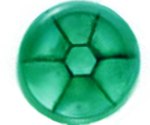 |
| Trapiche Emerald |
Nearly all emeralds are treated. Since approximately 600 years they were oiled (e.g. with cedarwood oil) to reduce the visibility of inclusions which break the surface. Unfortunately oils tend to dry out, therefore treated stones require a new oiling from time to time. A modern, more or less permanent treatment is the replacing of oil by more durable epoxy resin or wax. These modern treatments are worldwide accepted.
⇐ Intro Page ⇐ Gemstones ⇐ Emerald